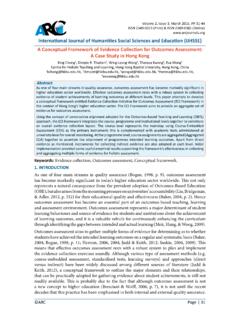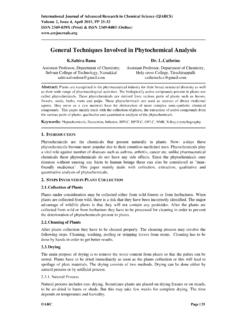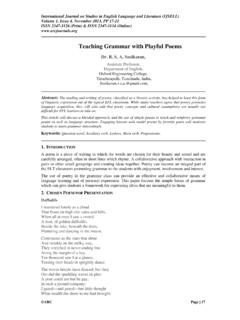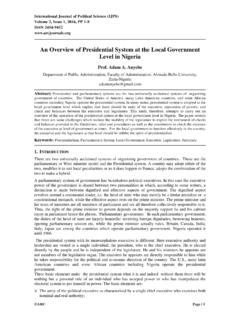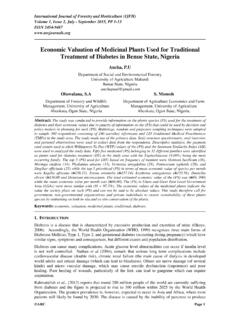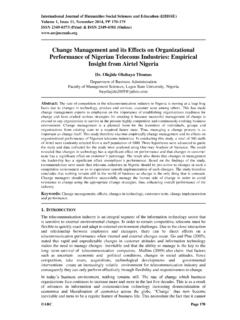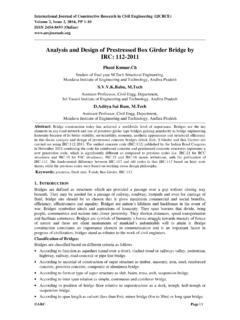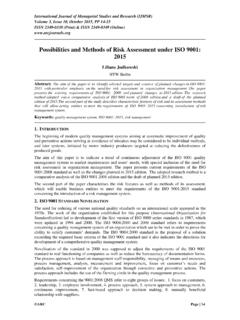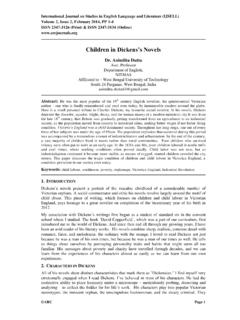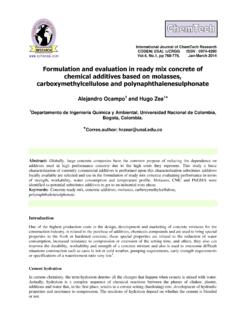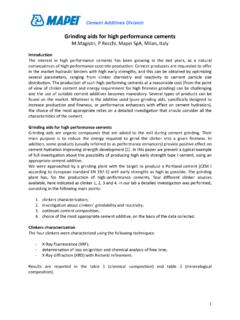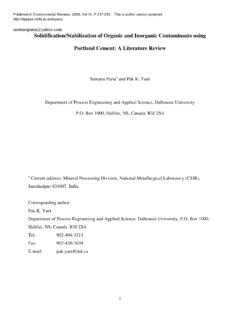Transcription of Minerals as Cr (VI) Reducing Additives and their Impact on ...
1 International Journal of Advanced Research in Chemical Science (IJARCS) Volume 1, Issue 8, October 2014, PP 31-39 ISSN 2349-039X (Print) & ISSN 2349-0403 (Online) ARC Page | 31 Minerals as Cr (VI) Reducing Additives and their Impact on cement Performance R. S. Vaity Research Scholar, Department of Chemistry, K. J. Somaiya College of Science & Commerce, Vidyanagar, Vidyavihar, Mumbai, India. J. K. Verma Adjunct Professor, Department of Chemistry, K. J. Somaiya College of Science & Commerce, Vidyanagar, Vidyavihar, Mumbai, India. Abstract: A potentially serious condition could occur when cement containing Cr (VI) comes into contact with the skin causing irritations and eczema.
2 A common strategy to surmount this difficulty is to reduce hexavalent chromium in cement using a Reducing agent in wet condition before putting to use cement -water paste. The objective of the present research work is to evaluate the effectiveness of various Minerals as Cr (VI) Reducing Additives to Portland cement . The Minerals used in the present study are bauxite, bentonite, attapulgite, china clay and jarosite. The Cr (VI) levels were tested using 1,5- diphenylcarbazide method at 540 nm on an UV-Visible spectrophotometer (according to the EN-196-10 method); the same were confirmed using ICP-OES technique. The physical testing of the cement mortar samples was carried out in order to understand the effect of these Additives on cement quality.
3 The mineral jarosite, was found to be the most efficient additive for Reducing Cr (VI) in cement and also, it was observed to be storage stable for the longest period (up to 90 days). XRD and SEM studies reveal that no phase alterations took place compared to the original cement sample. Thus, jarosite emerges as a good Reducing agent for the reduction of hexavalent chromium in cement at 3 % (w/w) solid dosage form, on account of its reduction efficacy, good storage stability, without impacting the physical properties of cement and its low cost. Keywords: Cr (VI), ICP-OES, SEM, XRD, compressive strength. 1. INTRODUCTION Chromium is an unavoidable trace element present in the raw materials [1, 2] used in the manufacture of cement clinker.
4 The oxidizing and alkaline burning conditions of the cement kiln form toxic Cr (VI). Hexavalent chromium is a powerful dermal irritant considered to be extremely toxic due to its high oxidation potential and ability to penetrate human tissue. It can cause skin sensitization, allergic reactions, and eczema [1, 2]. Chromium (VI) has high solubility in water and is released when cement is mixed with water. Thus, wet cement poses a health issue to workers who come into contact with wet cement or concrete. In European countries the COSHH (Control of Substances Hazardous to Health) regulations are in place for Cr (VI) in wet cement according to which the allowed level of Cr (VI) in dry cement is less than 2 ppm. Various Additives are available in the market for Reducing Cr (VI).
5 Furthermore, the European directive requires that delivery documents and cement bags be marked with information with respect to the period of time for which the Reducing agents remain potent; BCA R. S. Vaity & J. K. Verma International Journal of Advanced Research in Chemical Science (IJARCS) Page 32 (British cement Association) member companies have initially declared shelf- life of cement with an additive as 61 days [3]. The reduction reaction that takes place when using ferrous sulphate as a chemical reducer for reduction of Cr (VI) in cement is the following: CrO42- + 3 Fe2+ + 4 OH- + 4 H2O Cr(OH)3 + 3 Fe(OH)3 However, it has been reported that the use of ferrous sulfate is not efficient because the dosage amount required for Reducing Cr (VI) to Cr (III) is, at least, ten times the stoichiometric amount of ferrous sulphate [4] to that of chromate present in the cement .
6 Many compounds such as stannous sulphate [5], manganous sulphates [6] disulphides, polysulfides [7], catalyzed hydrazine compounds [8], hydroxyl amine and hydrazine compounds [9], sulphate dispersions [10] and aldehydes and carboxylic acids [11] have been recommended as Additives for reduction of Cr (VI). The present work is an attempt to study five Minerals viz., bauxite, bentonite, attapulgite, china clay and jarosite as Reducing agents for Cr (VI) in Portland cement . Bauxite is an aluminium rich mineral, whereas bentonite and attapulgite are clays comprising of aluminosilicate structure, with Na, K and Mg as main cationic components. China clay contains kaolinite as basic mineralogical phase with double layer silicate structure.
7 Jarosite is the mineral composed of iron, calcium and aluminium sulphates. Best two Reducing Additives viz., jarosite and bentonite among the five Minerals studied, have been further evaluated for their influence on the physical parameters viz., normal consistency, setting time and compressive strength of cement . Some of the cement samples were also studied by XRD and SEM for phase alteration in cement samples with Additives . 2. MATERIALS AND METHODS Minerals viz., bauxite, bentonite, attapulgite and china clay for the study were obtained from M/S Ashapura Minechem Ltd., Gujarat and the mineral jarosite was procured from M/S Hindustan Zinc Ltd. The Minerals in the powder form were used as supplied. All reagents/chemicals used were of analytical reagent grade from Merck.
8 Type I water was used throughout the work. Incorporation of the Various Additives in cement A cement specimen having Cr (VI) equivalent to 18 ppm was prepared (referred as original cement sample) to carry out all the experiments with different Additives . The Additives used were bauxite, bentonite, attapulgite, china clay and jarosite. Each of the Additives in powder form were blended with the cement in % (w/w), % (w/w), % (w/w), % (w/w), and % (w/w) dosage levels and used for performing the experiments. The details regarding the cement batches thus prepared are recorded in Table The prepared samples were stored in doubly sealed polythene bags for the experimentation. Table 1. cement batches prepared with various dosage levels Sr.
9 No. Type of Mineral additive % Dosage (w/w) 1 Bauxite 1 2 3 4 5 2 Bentonite 1 2 3 4 5 3 Attapulgite 1 2 3 4 5 4 China clay 1 2 3 4 5 5 Jarosite 1 2 3 4 5 Storage Stability Determination of Additives in cement The Cr (VI) contents in the samples stored in polythene bags were determined at periodic intervals to understand the efficacy of the Additives with respect to time. In order to determine Cr (VI) in cement samples the spectrophotometric method using 1, 5-diphenylcarbazide reagent was Minerals as Cr (VI) Reducing Additives and their Impact on cement Performance International Journal of Advanced Research in Chemical Science (IJARCS) Page 33 employed [12]. The detailed methodology of the same is described in Sub-secs.
10 And Cr (VI) in cement was estimated on 0, 8, 15, 30, 60 and 90 days. Estimation of Water Soluble Cr (VI) Preparation of Standard Calibration Curve for Estimating Cr (VI) Using an Uv-Visible Spectrophotometer Varying aliquots viz., , , ..mL of 100 ppm of Cr (VI) solution were pipetted out into different 100 mL volumetric flasks. 2 mL of 6N sulphuric acid were added to each flask, followed by 2 mL of % 1,5-diphenyl carbazide reagent [13]. The volume in each flask was made to 100 mL with de-ionized water. The absorbance of each solution was measured at 540 nm on Shimadzu UV-2450-spectrophotometer. Extraction of Water Soluble Cr (VI) in cement Samples The samples were homogenized for uniformity and representative samples were prepared.
